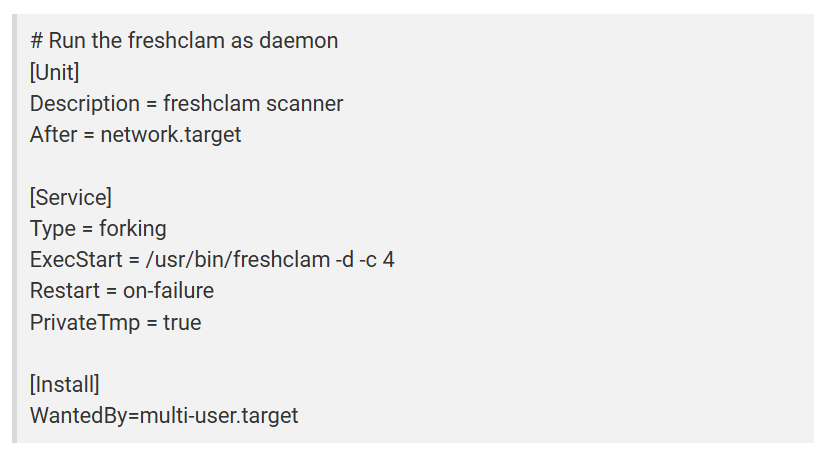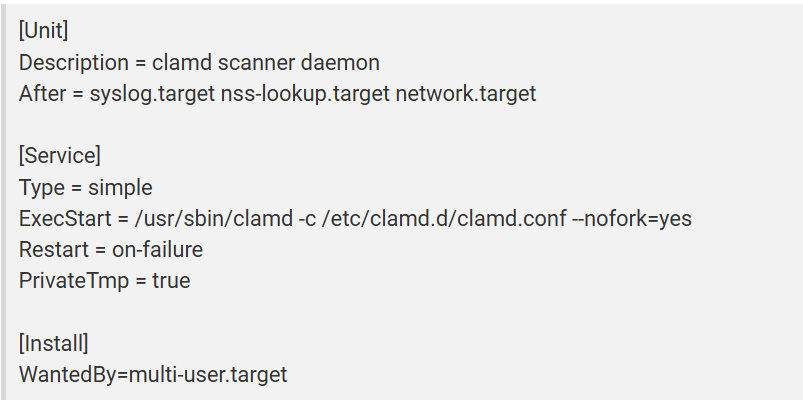Lynis is an open-source security auditing tool used by system administrators, security professionals, and auditors to assess the security defenses of Linux and UNIX-based systems. It runs directly on the host, performing more comprehensive security scans than typical vulnerability scanners.
ClamAV is an open-source (GPL) antivirus engine used for various purposes, such as email scanning, web scanning, and endpoint security. It includes several utilities, such as a flexible, scalable multi-threaded daemon, a command-line scanner, and an advanced tool for automatic database updates.
WARNING
CentOS 7 reached its end-of-life (EOL) on June 30, 2024:
CentOS 7 EOL Announcement
As a result, you may encounter repository issues. We recommend installing another OS that has not yet reached EOL.
If you are using CentOS 7 and face a mirror issue, check this guide to resolve it.
0. Preliminary Requirements:
"CentOS 7" template installed on the server.
"nano" text editor installed (yum install nano -y).
1. Installation of Lynis:
mkdir /usr/local/lynis
cd /usr/local/lynis
wget https://downloads.cisofy.com/lynis/lynis-2.7.5.tar.gz
tar -xvf lynis-2.7.5.tar.gz
The latest version can be found at: Lynis Download
2. Using Lynis:
To run Lynis, navigate to its folder:
cd /usr/local/lynis/lynis
To view the Lynis tutorial:
./lynis
To check the entire VPS:
./lynis --check-all
1. Installation of ClamAV:
yum install epel-release
yum update
yum install clamav-server clamav-data clamav-update clamav-filesystem clamav clamav-scanner-systemd clamav-devel clamav-lib clamav-server-systemd
2. Enabling Freshclam:
Freshclam keeps ClamAV up to date. In this tutorial, it's set to check for updates four times daily.
cp /etc/freshclam.conf /etc/freshclam.conf.bak
sed -i '/Example/d' /etc/freshclam.conf
Edit the "clam-freshclam.service" file:
nano /usr/lib/systemd/system/clam-freshclam.service
Paste the following content:

Enable Freshclam to start automatically:
systemctl enable clam-freshclam.service
systemctl start clam-freshclam.service
To manually update the ClamAV virus database:
freshclam
3. Configuring ClamAV Daemon:
cp /usr/share/clamav/template/clamd.conf /etc/clamd.d/clamd.conf
sed -i '/Example/d' /etc/clamd.d/clamd.conf
mv /usr/lib/systemd/system/clamd@.service /usr/lib/systemd/system/clamd.service
Now, update the clamd service file:
nano /usr/lib/systemd/system/clamd.service
Content to add:

Move to the "system" directory:
cd /usr/lib/systemd/system
Enable clamd to start automatically:
systemctl enable clamd.service
systemctl start clamd.service
4. Manual Scan Options:
To scan all files on the VPS and display the name of each file:
clamscan -r /
To scan all files on the VPS and display only infected file names:
clamscan -r -i /
To scan all files on the VPS, showing only infected file names while running the scan in the background (use the jobs command to check scan progress):
clamscan -r -i / &
To scan all files in user home directories:
clamscan -r /home
To scan all files in a user's directory and move infected files to a quarantine directory:
clamscan -r --move=/home/USER/Quarantine /home/USER
To scan all files in a user's directory and delete infected files:
clamscan -r --remove /home/USER